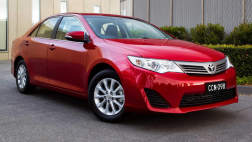It's not called the Celica yet, and it's not confirmed for production yet, but the Toyota FT-86 Concept is the best sign yet that the world's biggest carmarker wants to put a sporty coupe back into its line-up. It is also proof that Toyota is serious about its sports car collaboration with Subaru, since the FT-86 packs a two-litre boxer engine under its bonnet that is being provided by its new go-faster partner.
The Toyaru coupe should go live within a year and is likely to make it to Australia in the early months of 2011 as both a Toyota and — with visual tweaking — a Subaru. No-one at Toyota Australia is prepared to talk about the FT-86, which will be rolled out at the Tokyo Motor Show this month as Toyota tries to put some positive spin back into the car business following the global economic meltdown.
Even Toyota in Japan is keeping everything but the basic details a secret. It admits the car has the 2-litre flat-four engine and says the car has an overall length of 4160mm, a width of 1760mm, is 1260mm tall and rolls on a 2570mm wheelbase. The car is a genuine five-seater with a low centre of gravity and lightweight construction. It is painted in a colour called Flash Red, with a leather-wrapped interior in black and cream. Toyota says the cabin is deliberately minimalistic to give a sporty feel, "with many of the structural elements left uncovered".
The other Toyota Tokyo concept to break cover this week is the FT-EV II, an electric city car. It is nowhere near as funky as the Renault and Peugeot electric concept cars that starred at the Frankfurt Motor Show last month, but it proves Toyota is accelerating plans to have a range of plug-in cars in production in the next few years.
Toyota says the EV-II is even smaller than its current baby, the iQ, but can still seat four adults. It uses drive-by-wire technology to replace the conventional steering wheel and pedals with a joystick, a move that also frees more legroom in the cabin. It has a low-set nose that even includes an extra window below the windscreen to improve visibility for parking, with sliding electric doors on both sides.
Proving the EV-II is a production testbed, Toyota claims a top speed of 100km/h and an 80-kilometre range between charges, although it has yet to reveal any details of the electric powerpack or battery system.





.jpg)

.jpg)

.jpg)

.jpg)
.jpg)

.jpg)




























.jpg)

_0.jpg)








